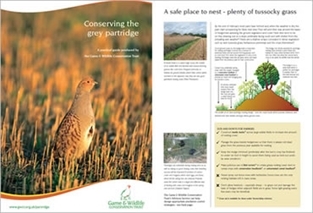Contents
The grey partridge originated as a grassland bird on the open, largely treeless, steppe. It nests on the ground, hidden in thick grass, and after the eggs hatch the hen partridge takes her brood of chicks to forage among the tall grasses or cereals for caterpillars, beetles, plant bugs and aphids. As they mature, these chicks begin to feed, like their parents, on young shoots and seeds.
Its steppe origin has allowed the partridge to adapt easily to cereal farmland. Thick vegetation at the base of a hedgerow makes an ideal nest site, and wheat and barley crops provide perfect cover from predators while the young brood is searching for insects.
A once-flourishing gamebird
 We can never know how many partridges existed in medieval England or earlier, but they were well distributed and in reasonable numbers. Farming was mixed and arable crops were full of insects and weeds. Nevertheless, predatory birds and mammals were common and partridge losses to these must have been high.
We can never know how many partridges existed in medieval England or earlier, but they were well distributed and in reasonable numbers. Farming was mixed and arable crops were full of insects and weeds. Nevertheless, predatory birds and mammals were common and partridge losses to these must have been high.
In the 19th Century, numbers of partridges dramatically increased following the period of land enclosure – with the patchwork-quilt landscape and quick-set hedges that we cherish today. After the Agricultural Revolution there was increased interest in managing game for sport and, by 1911, there were about 25,000 gamekeepers nationwide protecting gamebirds. At this time we estimate from bag data that there must have been more than a million pairs of grey partridges breeding in Britain.
In the 1950s, a sharp decline in partridge numbers followed the introduction of herbicides into modern cereal-growing systems. This was exacerbated by a loss of hedgerows and the employment of fewer gamekeepers. In the early 1990s there were around 145,000 partridge pairs, but ongoing monitoring suggests that numbers have halved since then.
A safe place to nest
By the end of February most pairs have formed and, when the weather is dry, the pairs start prospecting for likely nest sites. They will pick their way around the bases of hedgerows assessing the ground vegetation and cover. Nest sites tend to be on free-draining soil on a slope preferably facing south and with shelter from the prevailing wet weather. Nests are a shallow scrape concealed in dense vegetation such as rank tussocky grass, herbaceous perennials and the crops themselves.
Dos and don’ts for farmers
 |
Construct beetle banks across large arable fields to increase the amount of nesting cover. |
 |
Manage the grass beside hedgerows so that there is always old dead grass from the previous year available for nesting. |
 |
Keep the hedge trimmed (preferably after the berry crop has finished) to under six foot in height to avoid them being used as lookout posts by avian predators. |
 |
Make judicious use of field corners to create grassy nesting cover next to cereal crops with conservation headlands, or unharvested cereal headland. |
 |
Never spray out fence rows with herbicides. Fence rows are the only nesting habitats left in many areas. |
 |
Don’t allow livestock – especially sheep – to graze out and damage the base of hedges when adjacent fields are in grass. Some light grazing every few years may be beneficial. |
Get your FREE Grey Partridge Conservation Guide
An essential guide to conserving the grey partridge produced by the Game & Wildlife Conservation Trust.
What's inside your FREE guide
✓ The decline of a common farmland bird
✓ A safe place to nest - plenty of tussocky grass
✓ Chick survival - insect food is crucial
✓ Surviving winter and spring - food and cover
✓ Conservation targets - Partridge Count Scheme
✓ Grey partridges and shooting
✓ Common questions
Download guide now >